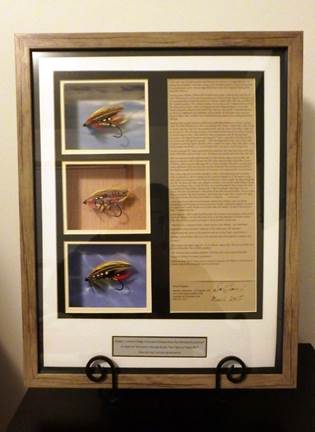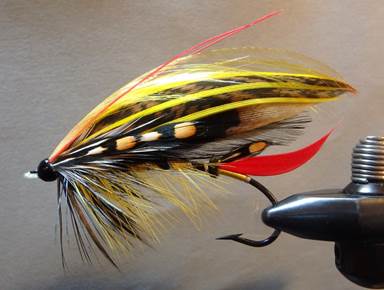- You are here:
- FAOL Home >>
- Articles >>
- Reviews >>
- Book and Video Reviews

Individual taste in books varies as much as the favorite rod or fly. With that in mind, we hope to review books and videos from the ever-growing fly fishing world, and share them with you. Books will be the best of all worlds, new and old. Many of the old books are now available in reprint, and the wisdom contained is timely today. Others can be found in second-hand book stores, or by mail order dealers. As we find videos we feel are outstanding they will be included. Be assured, reviews are based on what we have actually read or viewed, and due to that fact, may not appear weekly.
REPRISE - ATLANTIC SALMON FLIES: TYERS & THEIR ART
ATLANTIC SALMON FLIES – Book Review
By Satoshi Yamamoto
Review 17: Reprise – Atlantic Salmon Flies: Tyers & Their Art by Judith Dunham (1991)
Tribute to Albert J. Cohen:
I have reviewed this book (Chronicle Books, ISBN: 0-87701-800-6) before (Review 3). This time I'd like to write a memoir regarding one of dressers in this book. Though I have never met him and will never will, I feel greatly obliged.
I have come across "Al Cohen" at every turning-point of my professional career with Atlantic Salmon Flies. First, it was this book. Although the book features many breath-taking flies by then world-class dressers, three of Al's "Unnamed Patterns From The 19th Century" are strikingly beautiful and some of most challenging patterns. At that point, I had not considered dressing them or wondered if I would ever reach the level necessary to challenge them.
The rest of the stories are too personal and too long to share in this chapter. One publically known fact is he passed away in 1996.
All of these coincidences motivated me and my skills and techniques matured (and are still growing). I completed three of "Unnamed Patterns From The 19th Century" and framed them with a personal memoir; homage and appreciation to Al that I hope he's hearing from somewhere above us.
|
|
Unnamed Pattern from The 19th Century (front cover) |
|
Unnamed Pattern from The 19th Century (page 88) |
|
Unnamed Pattern from The 19th Century (page 91) |
If I would stop here, this chapter would just be a poignant tribute to one of our predecessors. However, Al's chapter (page 88-92) contains some very technical comments that really established me; or I should say: his words really broke shells around me and I stepped out of my then level and skills into a higher level. It may not be my physical skills, rather "concepts": the way I see Atlantic salmon flies and interpret what historical authors meant to say and what we modern dressers do.
As I observed pictures of his flies numerous times, checking to see if I have enough and proper materials and planning step-by-step, I read his chapter repeatedly. I had noticed something growing and changing within me.
"(After reading historical books and examining antique flies) a tremendous amount of fly-dressing history was not recorded, and as a result, much today is subject to conjecture and speculation".
"I believe that any concepts of rules and proportions are nothing more than preposterous attempts at promulgating what never existed or could ever exist – sheer poppycock!"
"Does anyone believe that George Kelson's dressings of Champions or James Wright's of Silver Greys or Daniel O'Fee's of Doherty's Judges, for example, were each dressed with identical components, in the same style, and in the same proportions? That assumption would be naïve. The more I looked at the subject and the more I read, the more I came to the conclusion that the only rule for tying Atlantic salmon flies was that the fly had to be dressed on a hook of some sort".
I was enlightened.
By then I was like "my mentor told me so and so", "he did this and that on his flies", or "this author says so and so in his book". Also at the same time, I had wondered every now and then "what difference would that make if I change this and that – for example color components of married wing?" But I wasn't sure and wasn't confident enough to try it. I was chained up inside of chamber "What Commonly Said & Done". Then Al's conceptual words and those words have been enlightening since the day that I read them. As long as I follow the principles = general methods and proportions = and then use proper materials, there is no right or wrong but "my" fly, that is one and only. I broke the chain and got out of the chamber. I became more confident and comfortable with each procedure and each fly.
First I read a fly recipe. I mentally list colors and characters of each material and then mentally draw pictures of how they look like in a group or next to each other. Once started dressing, I remain flexible if and when my mental drawings would not turn up what I would have imagined. I redraw and am willing to reconstruct, say, color scheme of married wings. Also, there are recipes with special notes, some of which are sometimes hard to understand or achieve, or even against "modern rules". There comes "interpretation", which has no right or wrong, again, as long as following the principles or as long as the dresser can validate his/her concept and why/how one has decided to do so.
This is when I grew up to be an artist from a fly-dresser.
|
The Captain – Yamamoto's Variant |
Al's writing is very philosophical.
"Have we considered that certain facets of fly-fishing – the sometimes superstitious and ritualistic behavior of the fisherman, the mystique surrounding the choice of fly patterns, the use of furs, hairs, and feathers – perhaps, just perhaps, link us to our ancestors and their amulets, charms, and fetishes."
He even left a prophecy.
"By dressing these antique patterns, I feel they have been entered into the stream of history for future generations."
Would you mind, Al, if I think of you as one of my ancestors who guides my journey?
Satoshi Yamamoto, www.leftyanglerandflies.com, is an outfitter and a fly-dresser in Livingston, MT.




